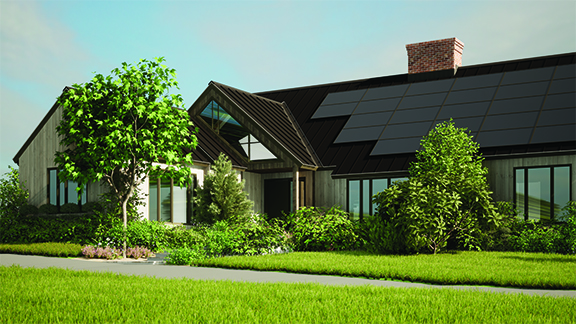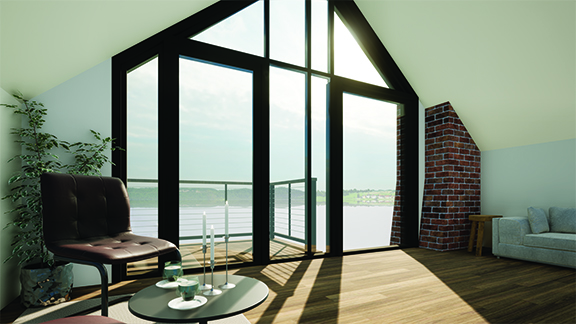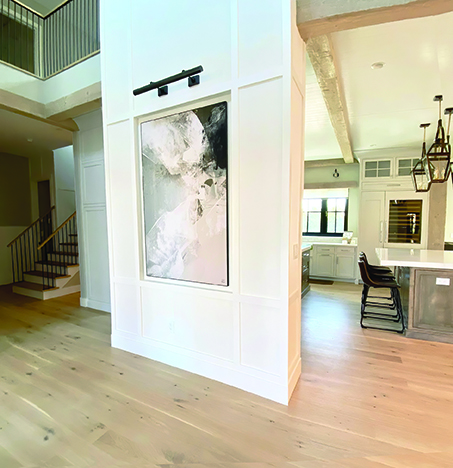 Net zero, Passive House, LEED Platinum—why are these building certifications important? Consider the nearly completed contemporary farmhouse on St. John’s Road in Ridgefield that will soon earn all these distinctions.
Net zero, Passive House, LEED Platinum—why are these building certifications important? Consider the nearly completed contemporary farmhouse on St. John’s Road in Ridgefield that will soon earn all these distinctions.
At 4000 square feet of energy efficient living space, the house will cost approximately $18 a month to heat, cool and electrify. It’s the Tesla of tech: it comes with all sorts of cool devices that can be operated right from a cell phone app, including a fresh air flow system. The garage has a blower to eliminate any carbon monoxide and several electric chargers for future vehicles.
While energy costs alone might be compelling enough reasons to go green, owners Aubre and Zac Weber were motivated for other reasons.
“We were led down this path because of our journey as parents and what we do for a living,” says Weber. She and her husband are both in the medical field and see first-hand many very sick people—including children who are dealing with health problems previously seen only in adults. They considered possible causes for this trend and came to a realization. “Your home has a much bigger impact on your health than many realize. We want people to see what living green can do for their health,” says Weber.
What does it really mean to go green? Industry professionals often balk at the term because from doing the bare minimum of using energy star appliances to going completely sustainable, Passive House, and as energy efficient as possible, there are many shades of green building. Thankfully, certifications help consumers understand what they are getting.
The Webers stuck to the most stringent standards available, making sure their home was not only energy efficient, but only used materials that had the least impact on the environment. The couple credits their “build team” of BPC Green Contracting, Trillium Architects, and Jill Rae Interior Designs, all of whom are equally as passionate about sustainable living. Everything in the house was selected for energy and material ratings and flow rates. They even insisted that their interior doors not be made from tropical woods.
Principal Architect Elizabeth DiSalvo of Trillium explains that new construction like the Weber’s begins with finding land that allows a house to be oriented to get the most passive solar heat gain along with some summer shading. Ideally, you want a sunny site that is not surrounded by a lot of trees, hills or wetlands.
Passive Homes are designed to have an airtight envelope which keeps insects, dust and mold from creeping into the house and keeps heating and air where it belongs—inside. The industry joke is that they are so airtight they could be heated with a hair dryer. Because the goal is to use alternative energy sources like solar, all the mechanicals, such as ventilation to keep fresh air circulating, are electric. DiSalvo says that clients have even reported that allergies have subsided once they’ve moved into their homes.
 Twelve-inch-thick walls with above code insulation along with triple pane windows create a better envelope with the ultimate goal of net zero consumption. Sustainability is achieved by using well-researched and time-tested products with less embodied carbon to reduce the carbon footprint. The Ridgefield farmhouse used almost no steel and a concrete alternative that contained significantly less cement. Instead of foam, which is worse for the planet than other insulations, environmentally friendly alternatives like AeroAggregates (made from 99% post-consumer recycled glass) as well as other natural and plant-based products were used.
Twelve-inch-thick walls with above code insulation along with triple pane windows create a better envelope with the ultimate goal of net zero consumption. Sustainability is achieved by using well-researched and time-tested products with less embodied carbon to reduce the carbon footprint. The Ridgefield farmhouse used almost no steel and a concrete alternative that contained significantly less cement. Instead of foam, which is worse for the planet than other insulations, environmentally friendly alternatives like AeroAggregates (made from 99% post-consumer recycled glass) as well as other natural and plant-based products were used.
The greatest advantage to the house for the Webers is peace of mind. There are no chemicals or gasses pouring into the home. They don’t worry their children will inhale propane gas as they have their Saturday morning pancake breakfast.
“I know every single material that went into my home. I have machines and apps that tell me what my air quality is and what devices are pulling too much electricity so I can shut them off,” says Weber.
DiSalvo estimates the cost of building a Passive House as between 2-5% greater than traditional building, however, because these houses are all electric, solar power will allow homeowners to recoup costs over time. Consumers can also take advantage of incentives and rebates. Homeowners should seek a build team that understands the industry. “Get multiple quotes and stick to your high standards. Even if you think you’ve done your research, go out and do some more,” says Weber.
Not everyone can start from scratch. For existing houses, homeowners can do a deep energy retrofit which removes the existing siding and shingles and blankets the house in 3-4 inches of continuous insulation board before re-siding and roofing. Once the house is reskinned and with new windows and additional insulation added, the energy retrofit is almost as good as building new.
 Additional ways to lessen our environmental impact include buying energy star appliances, replacing old and inefficient heating and air units, using LED lighting, and insulating attics and basements. And, of course, adding solar panels or solar roof tiles make use of alternative energy as well as significantly lowering utility costs.
Additional ways to lessen our environmental impact include buying energy star appliances, replacing old and inefficient heating and air units, using LED lighting, and insulating attics and basements. And, of course, adding solar panels or solar roof tiles make use of alternative energy as well as significantly lowering utility costs.
“Don’t listen to those who tell you it is hocus pocus to build like this or that it’s not worth the money,” advises Weber. “Yes, it is expensive to build green, but it is becoming more and more affordable every day. Look around and wonder what is impacting you, your children, your loved ones, your community, your earth.” •